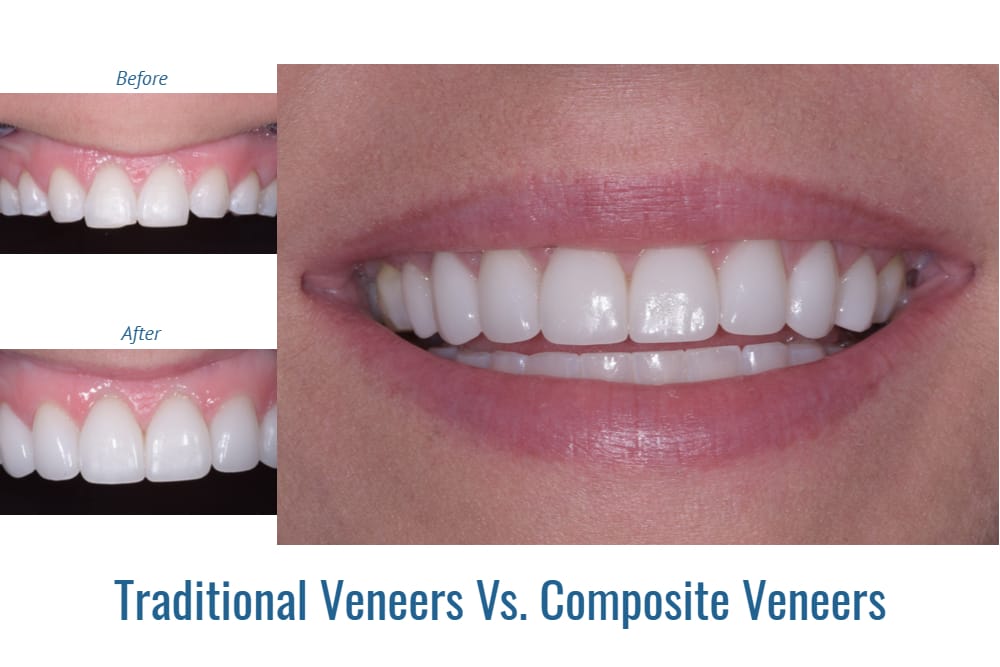
Veneers are an excellent option to help revitalize your smile. Whether you have a gap between your teeth or you want to change the overall shape of your teeth, veneers can make that happen. However, when people first come in for their cosmetic dentistry consultation to discuss veneers, many of them are surprised that there is more than one type of veneer.
If you have been considering veneers, knowing how traditional porcelain veneers compare to composite veneers can help you take the plunge.
What Are Traditional Veneers And Composite Veneers
Commonly, when people talk about veneers, they are talking about traditional veneers which are made of thin porcelain. These veneers are made from an impression of your teeth so that they are perfectly-fitted and highly durable.
Now, that’s not to say that composite veneers are a bad choice—because they are great. This type of veneer is made of composite resin, which can be quickly applied to your teeth for a fast and attractive smile makeover.
How Do Traditional Veneers Compare To Composite Veneers
Now that you have the basics of what these veneers are, here’s how porcelain veneers compare to composite veneers.
Cost
The cost of these different veneers creates the biggest divide, as a single porcelain veneer costs about $1,000. Compare that to the cost of a single composite veneer, which can cost about $250. That price gap often is tough to bridge, especially if you are financing your veneers out-of-pocket.
However, the durability of these veneers will also need to be factored in when it comes to the overall cost.
Durability
While composite veneers are very affordable, they will generally only last between 4-8 years before you need to have them reapplied. While composite resin veneers are strong, they are far more prone to chipping than porcelain veneers. On the plus side, if a composite veneer becomes chipped, it can be repaired.
Compared that durability to porcelain veneers, which will generally last for 10-15 years with the proper care. Once the porcelain veneers are bonded with your healthy teeth, they should not be more chip-prone than your natural teeth. However, if your porcelain veneers become chipped or damaged, they will need to be replaced entirely and can’t be repaired like composite veneers.
Application
Porcelain veneers will take at least two visits to be applied. First, our dentists have to remove some of the dental material, then take an impression of the teeth which will receive the porcelain veneers. The impression will be sent to a dental fabrication lab to make your custom traditional veneers. Between the visits, you can have a set of temporary veneers, though that can add to the overall costs.
With composite veneers, the turnaround time is much faster. You can have composite veneers applied within one session with our dentist. Also, in most cases, you won’t need any dental material removed. That way, if you want to remove your veneers later, there is no problem. But with porcelain veneers, you will need some kind of replacement, as you will be missing enamel.
Aesthetics
With both types of veneers, you have options when it comes to the shade they come in. But, with composite veneers, keeping the color the same can be tough, as they can become stained like your natural teeth.
As for porcelain veneers, they are stain-resistant, allowing you to have a brighter, whiter smile without worry. Also, while composite resin is dense like the natural tooth material, porcelain veneers are able to reflect light the way your natural teeth do, making them appear more natural than composite veneers.
How To Decide Which Type Of Veneer Is Right For You
Here at Riverside Dental Care, our dentists offer both types of veneers, as both types meet different needs for our dental patients. Some of the factors that can help you decide between porcelain veneers vs. composite veneers are:
- Porcelain veneers are great for someone who wants to make big changes to entire smile, as they can be applied consistently and remain attractive for many years to come.
- Composite veneers are ideal for someone who wants to make small, subtle changes to their smile for a more even appearance.
- Porcelain veneers are an excellent cosmetic choice for closing gaps between teeth, correcting staining, lengthening teeth that are too short, and fixing chips.
- Composite veneers are more affordable, allowing you to afford the cosmetic changes you want without waiting to save up.
- Porcelain veneers work well long term and allow you to have a great smile for at least a decade without needing more work.
- Composite veneers are great for teeth with chipped edges, permanently stained teeth correction, and filling in the gaps between your teeth.
To consult with our dentists concerning your veneers, contact us today. We look forward to helping you achieve your ideal smile!



Leave a Reply